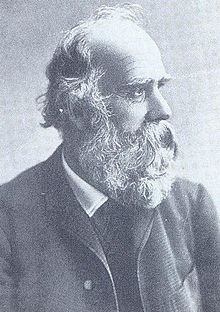German wolf
German Wolf (born October 12, 1830 in Nendingen , † April 17, 1890 in Konstanz ) was a pioneer of photography in southern Germany and court photographer of the Grand Duke of Baden .
Life
German Wolf grew up in a middle-class environment. His father was the parish clerk Adam Wolf, who was the successor of Barnabas Mattes mayor of Nendingen from 1861 to 1869 .
After his training in Nendingen, German Wolf married Barnabas Mattes' daughter Maria. Their son Alfred later followed in his father's professional footsteps. The young family went to Stuttgart , where German Wolf acquired new knowledge about photography. Wolf worked as a traveling photographer in southern Germany and Switzerland for several years. On November 1, 1859, he took over his elegant, well-lit studio at Tübinger Str. 7 in Stuttgart from Johann Michael Holder . He made a name for himself, in particular through photographs of Crown Prince Karl I and Crown Princess Olga as "a master in his art". After Martini (November 11th) 1861, Wolf moved into his new studio in the rear building at Marienstraße 14, where he worked until he moved to Constance.
Since his first wife Maria died early, Wolf married Pauline Herter in Konstanz on May 23, 1864. In the same year he moved there and founded the company "Art Institute and Publishing House, Architecture and Landscape Photography up to the Largest Formats". With his second wife he had the son Eugene . His company in Konstanz was later successfully continued by his two sons.
plant

In 1858, with a sense of homeland, he took the first photograph of his native Nendingen .
Wolf's sensational photographs of the fresco paintings commissioned by King Wilhelm of Württemberg in the New Palace were the reason for the royal Württemberg Medal of Merit for Art and Science.
In 1870 he was awarded the title of court photographer by Grand Duke Friedrich von Baden for documenting city views, monuments, personalities and social events in Constance .
More than 7,500 plate negatives from Wolf's studio are now in the Konstanz city archive.
Individual evidence
- ↑ a b Joachim W. Siener: Die Photography and Stuttgart ... , p. 103
- ↑ Stuttgarter Zeitung , 1860
- ^ " Gränzbote " of September 27, 1861
bibliography
swell
- Joachim W. Siener: The photography and Stuttgart 1839-1900. From the masked sleigh ride to the court photographer , Cantz edition: Stuttgart 1989, ISBN 3-89322-150-6
- Paul Motz: The old Konstanz in pictures of the court photographer Wolf from the years 1860 to 1918 , Stadler: Konstanz 1966
Further literature
- Jürgen Klöckler, Norbert Fromm: Between the Middle Ages and the Modern . Constance in early photographic representations: Pictures from the Wolf Collection 1860-1930 (= Konstanzer Geschichts- und Rechtsquellen . Volume 38 ). Thorbecke, Ostfildern 2003, ISBN 978-3-7995-6838-8 , pp. 144 .
- Jürgen Klöckler, Norbert Fromm: Lake Constance in early pictures . Photographs from the Wolf Collection 1860-1930 (= Konstanz historical and legal sources . Volume 39 ). Thorbecke, Ostfildern 2005, ISBN 978-3-7995-6839-5 , pp. 144 .
- Norbert Fromm: The Constance photographer dynasty Wolf. Good light! , DRW-Verlag Weinbrenner: Karlsruhe 2003
- Norbert Fromm: The Wolf estate in the Konstanz city archive , Theiss: Stuttgart 1992
- Helmut Maurer: The court photographer German Wolf (1830–1890) and Konstanz in the late 19th century , Konstanz 1979 (= Konstanzer Almanach 25)
- Erich Hofmann, Paul Motz: The old Constance in pictures by the court photographer Wolf from the years 1860 to 1918 . Friedr. Stadler, Konstanz 1966, p. 136 .
Web links
| personal data | |
|---|---|
| SURNAME | Wolf, German |
| BRIEF DESCRIPTION | German pioneer of photography |
| DATE OF BIRTH | October 12, 1830 |
| PLACE OF BIRTH | Nendingen |
| DATE OF DEATH | April 17, 1890 |
| Place of death | Constancy |

